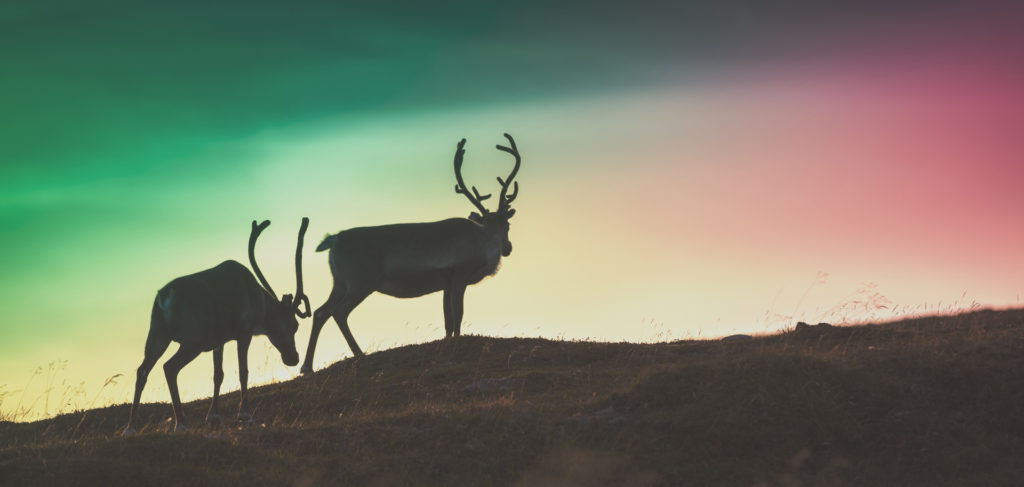How Do Reindeers Adapt to Lapland’s Environment?
Lapland, a region known for its breathtaking landscapes and harsh Arctic climate, is home to one of nature’s most resilient creatures: the reindeer. These majestic animals have evolved a range of adaptations that allow them to thrive in this challenging environment. In this blog post, we will explore the various ways reindeers adapt to Lapland’s environment, from their physical characteristics to their behavioural patterns and dietary habits. As experts in Lapland travel, we at VALO Finland aim to provide you with a comprehensive understanding of these fascinating creatures and their role in the Lapland ecosystem.
Physical Adaptations of Reindeers in Lapland
Reindeers possess several physical adaptations that enable them to survive the extreme conditions of Lapland. One of the most notable features is their thick fur, which consists of a dense undercoat and longer guard hairs. This dual-layered fur provides excellent insulation against the cold, keeping the reindeer warm even in sub-zero temperatures.
Their hooves are another remarkable adaptation. Reindeers have large, splayed hooves that act like snowshoes, distributing their weight evenly and preventing them from sinking into the snow. These hooves also have sharp edges that help them dig through the snow to find food.
Additionally, reindeers have a unique nasal structure that warms the cold air before it reaches their lungs. This adaptation is crucial for maintaining their body temperature and ensuring efficient respiration in the frigid Arctic air.
Behavioural Changes to Survive Lapland’s Harsh Climate
Reindeers exhibit several behavioural adaptations to cope with the harsh climate of Lapland. One of the most significant behaviours is their migratory pattern. Reindeers migrate over long distances between their summer and winter habitats. During the summer, they move to higher altitudes where the temperatures are cooler and food is abundant. In the winter, they descend to lower altitudes to escape the severe cold and find shelter.
Another behavioural adaptation is their social structure. Reindeers live in herds, which provides them with protection against predators and helps them conserve body heat. The herd dynamics also facilitate the sharing of information about food sources and safe routes.
Reindeers are also known for their ability to reduce their metabolic rate during the winter months. This adaptation allows them to conserve energy when food is scarce, ensuring their survival until the more bountiful summer season.
Dietary Adjustments for Lapland’s Flora and Fauna
The diet of reindeers is highly adaptable, allowing them to make the most of the available flora and fauna in Lapland. During the summer months, reindeers graze on a variety of vegetation, including grasses, leaves, and herbs. This diverse diet provides them with the necessary nutrients to build up their fat reserves for the winter.
In the winter, when the ground is covered in snow, reindeers rely heavily on lichens, a type of symbiotic organism that grows on rocks and trees. Lichens are rich in carbohydrates and provide a crucial energy source during the colder months. Reindeers use their sharp hooves to dig through the snow and access these lichens.
Reindeers also consume other available food sources such as mosses, fungi, and even small shrubs. Their ability to digest a wide range of plant materials is facilitated by their specialised rumen, which contains microorganisms that break down tough plant fibres.
Reproduction and Life Cycle Adaptations in Lapland
Reindeer reproduction is timed to ensure that calves are born during the most favourable conditions. Most reindeer calves are born in May or early June, coinciding with the warmest and greenest time of the year in Lapland. This timing allows the calves to take advantage of the abundant food supply and mild weather, increasing their chances of survival.
Newborn reindeer are remarkably resilient. They are born with a thick layer of fur and a layer of fat that provides insulation against the cold. Within a few hours of birth, they are able to stand and follow their mothers, which is crucial for avoiding predators and staying with the herd.
Reindeer calves grow rapidly, thanks to their mother’s nutrient-rich milk. Within a week, they begin to graze on vegetation, and their antlers start to grow. Reindeer antlers are the fastest-growing bones in the animal kingdom, and both males and females grow them, although females shed theirs after giving birth.
Role of Reindeers in the Lapland Ecosystem
Reindeers play a vital role in the Lapland ecosystem. As herbivores, they help to control the growth of vegetation, preventing overgrowth and maintaining a balanced ecosystem. Their grazing habits also promote the growth of certain plant species, contributing to biodiversity.
Reindeers are also an essential part of the food chain. They serve as prey for predators such as wolves and bears, supporting the survival of these species. Additionally, their droppings provide nutrients for the soil, promoting plant growth and supporting other wildlife.
In Lapland, reindeers hold cultural and economic significance as well. Reindeer herding is a traditional practice among the Sámi people, who have relied on these animals for food, clothing, and transportation for centuries. This practice continues to be an integral part of Sámi culture and heritage.
At VALO Finland, we are committed to providing our guests with an immersive experience of Lapland’s unique environment and wildlife. Our luxury villas offer the perfect base for exploring the region and learning more about the fascinating adaptations of reindeers. Whether you are interested in guided tours, wildlife observation, or simply enjoying the serene beauty of Lapland, we are here to make your stay unforgettable.
We invite you to discover the magic of Lapland and the incredible adaptations of its wildlife. With our expert guidance and luxurious accommodations, your journey to Lapland will be an experience of a lifetime. Book your stay with VALO Finland and embark on an adventure that will leave you with lasting memories and a deeper appreciation for this remarkable region.
